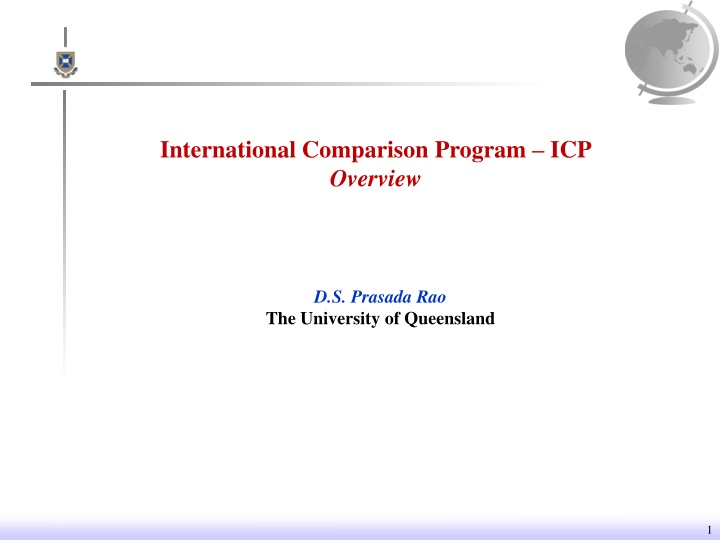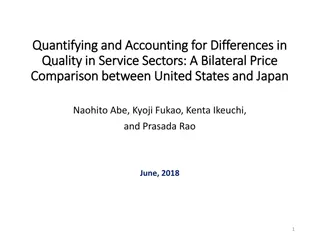
ICP Overview & Purchasing Power Parities in Global Economic Comparisons
Learn about the International Comparison Program (ICP) and Purchasing Power Parities (PPPs) in global economic comparisons. Explore how ICP provides internationally comparable statistics on GDP, government expenditure, and more across countries. Understand the governance structure, workflows, and importance of PPPs in understanding currency values worldwide.
Download Presentation

Please find below an Image/Link to download the presentation.
The content on the website is provided AS IS for your information and personal use only. It may not be sold, licensed, or shared on other websites without obtaining consent from the author. If you encounter any issues during the download, it is possible that the publisher has removed the file from their server.
You are allowed to download the files provided on this website for personal or commercial use, subject to the condition that they are used lawfully. All files are the property of their respective owners.
The content on the website is provided AS IS for your information and personal use only. It may not be sold, licensed, or shared on other websites without obtaining consent from the author.
E N D
Presentation Transcript
International Comparison Program ICP Overview D.S. Prasada Rao The University of Queensland 1
What is ICP? ICP International Comparison Program is a global international statistical initiative designed to provide internationally accounts aggregates: comparable national Purchasing Power Parities of currencies (PPPs) Real gross domestic product (GDP) which is comparable across countries Components Government Expenditure and Gross Fixed Capital formation of GDP Private Consumption; Price levels across countries 2
ICP Benchmarks country participation ICP started as a research project at the University of Pennsylvania by Kravis, Heston, Summers and Kenessey ICP Phase Benchmark year No. of participating countries 10 16 34 60 64 117 146 177 (+22) I 1970 1973 1975 1980 1985 1993 2005 2011 II III IV V VI VII VIII OECD and Eurostat compile PPPs for their member countries more frequently. Eurostat compiles PPPs compiles PPPs on an annual basis using rolling price surveys. 3
Purchasing Power Parities (PPPs) PPPs are amounts of currencies, of different countries, that have the same purchasing power as one unit of a reference currency (e.g. US$) with respect to a selected basket of goods and services. 4
ICP Governance UNITED NATIONS STATISTICAL COMMISSION ICP Executive Board ICP Secretariat (housed at the World Bank) Independent Technical Advisory Group Independent Calculation and Results Review Groups Regional Implementation Agencies Singleton Countries Pacific Islands Africa Asia Pacific CIS LAC Eurostat- OECD Western Asia 2 23 50 23 9 39 47 12 # countries 5
ICP Workflow Country Statistical Offices ICP Secretariat (World Bank) Computation of regional results Price collection and expenditure data compilation Regional Implementing Agencies Linking regional results to produce global results 6
Framework for PPPs ICP Approach Global linking Global Core prices Linking Factors Productivity Adjustment GEKS for the whole world Fixity Country Aggregation and Redistribution (CAR) method 8 8
ICP/PPP Data Requirements Price data requirements National annual average prices for household consumption items - for example, white rice under basic heading Rice Approx. 620 global core list products Supplemented with additional approx. 1000 region-specific products Price data for special surveys covering other GDP components: Housing; private education; government compensation; machinery and equipment; and construction Price data must be consistent with national accounts measurements National accounts expenditure data requirements National accounts expenditures for 155 headings 9
ICP/PPP Key Concepts Product characteristics Representative/importance: products prices reflect purchases in the region/country Comparability: products are sufficiently similar (and well-defined) for inter-country comparisons Expenditure characteristics Conform to System of National Accounts concepts , definitions and valuation methods Reflect total volumes of transactions for goods and services in the country 10
ICP Classification Gross Domestic Product Expenditure Levels Published Individual consumption by government Individual consumption by households 7 Main Aggregates Gross fixed capital formation Alcoholic Beverages & Alcoholic Beverages & Tobacco Tobacco 26 Food & Non-Alcoholic Beverages Categories Non-Alcoholic Beverages 61 Groups Food Food Unpublished Meat Meat Bread & Cereals Bread & Cereals Fish Fish 126 Classes 155 Basic Headings Rice Bread Pasta 11
DEFINING PRODUCTS Structured product descriptions (SPDs) provide a structured method for systematically describing all price-determining characteristics for every possible product consumers can purchase. These characteristics are used to define the different kinds of milk, for example, that can be purchased. (SPD parameters) CodeName Quantity Product Packaging Brand name Processing characteristic 1101141 Fresh milkNumber Unit of measure ment Min Max Brand Packaging Fat of units content 110114101 Milk, un- 1 Liter 0.8 1.5 Well known Pre-packed; Pasteurised; HTST (High Temperature/Short Time) treatment Natural (3-4%) skimmed Pasteurized carton 110114102 Milk, un- 1 Liter 0.5 1.5 Well known Pre-packed; Ultra High Temperature (UHT) Natural (3-4%) skimmed UHT carton 12
Survey Framework 3 main sampling aspects of the household consumption price survey Stratifying a country to ensure all geographical locations are covered 1 Selection of individual outlets within identified geographical locations 2 Selection of products to be priced 3 STRATIFYING A COUNTRY Country/Economy A Region A Region B Rural Urban Rural Urban Village A Village C City B Village B City A City D Village D City C 13
Selecting Outlets Outlet Definitions Bulk and Discount Shops Specialized Shops Private Service Providers Public or Semi-Public Service Providers Other Kinds of Trade Large Shops Medium and Small Shops Markets Street Outlets Type Example Definition Neighborhood shop: The purpose of the retail shop is to blend in with the surrounding neighborhood and focus on local tastes and needs Minimarkets, Kiosks, Neighborhood shops, Grocery stores, Convenience stores, etc. Medium and Small Shops 14
Price Surveys in China - ICP 2011 The International Statistical Information Centre under the NBS established the ICP Division to oversee all matters relating to ICP. Survey Design Data aggregation Technical assistance for local offices Liaising with international organizations including Asian Development Bank and the World Bank ICP price collection used: Statistical Infrastructure for ICP price collection CPI survey organization Sample Outlets etc 15
Price Surveys in China ICP 2011 Source: ADB (2015) Price surveys in China for 2011 ICP are extensive and have a national coverage. This is in contrast to limited surveys in 2005 ICP covering only 11 capital cities and surrounds. 16
Price Surveys in China ICP 2011 Source: ADB (2015) 17
Price Surveys in India ICP 2011 ICP activities in India were conducted by the Prices Unit of the National Accounts Division, Central Statistical Office. Consumption surveys were conducted by the National Sample Survey Office Prices were collected by the Central Public Works Department Infrastructure for ICP Data collection CPI infrastructure (outlets, markets, etc.) Since ICP specifications are different from CPI products, separate questionnaires were used. Survey framework Prices for food, clothing and footwear - quarterly Prices for fruits and vegetables monthly Other household items twice a year 18
Price Surveys in India ICP 2011 Source: ADB (2015) 19
PPPs from ICP 2011 (selected countries) Country Exch. Rate US$ 6.461 7.784 46.67 0.969 79.809 0.719 16.899 0.719 PPP PLI% (World=100) 70.0 90.5 41.7 201 173.6 162.4 37.5 148.8 P.R. China Hong Kong India Australia Japan Luxembourg Ethiopia Austria 3.506 5.462 15.109 1.511 107.454 0.906 4.919 0.830 Source: World Bank, 2014, Results from ICP 2011. 21
ICP 2011: 12 Largest Economies in 2011 Ranking by GDP (PPP-based) 1 2 3 4 5 6 7 8 9 10 11 12 Share of world GDP (PPP-based, world = 100) Share of world GDP (exchange rate based, world = 100) Ranking by GDP per capita (PPP-based) Economy United States China India Japan Germany Russia Brazil France United Kingdom Indonesia Italy Mexico 17.1 14.9 6.4 4.8 3.7 3.5 3.1 2.6 2.4 2.3 2.3 2.1 22.1 10.4 2.7 8.4 5.2 2.7 3.5 4.0 3.5 1.2 3.1 1.7 12 99 127 33 24 55 80 30 32 107 34 72 Source: World Bank, Results from ICP 2005 and 2011. 22
Ranking of economies by real per capita GDP and Price levels Ranking by GDP PLI 1 2 3 4 5 6 7 8 9 10 Ranking by GDP (PPP- based, per capita) Economy GDP PLI (world = 100) GDP PLI (US = 100) Switzerland Norway Bermuda Australia Denmark Sweden Japan Finland Luxembourg Canada 209.6 206.4 201.6 201.0 185.0 175.1 173.6 162.6 162.4 161.9 162.6 160.0 156.4 155.9 143.5 135.8 134.6 126.1 126.0 125.6 10 7 9 20 21 22 33 28 3 23 168 169 170 171 172 173 174 175 176 177 Cambodia Uganda Vietnam India Bangladesh Lao PDR Ethiopia Myanmar Pakistan Egypt 42.8 42.6 42.2 41.7 40.3 39.6 37.5 37.0 36.4 35.1 33.2 33.0 32.7 32.4 31.2 30.7 29.1 28.7 28.2 27.2 146 156 128 127 144 133 169 139 129 97 Source: World Bank, Results from ICP 2011. 23
ICP 2011: Regional GDP Shares Based on PPPs 53.7 Eurostat-OECD 70.1 Based on XRs 30.0 Asia and the Pacific 17.9 5.5 Latin America 5.3 4.8 CIS 3.4 4.5 Western Asia 2.8 4.5 Africa 2.7 1.6 Other 0.9 Source: World Bank, Results from ICP 2011. 24
Global Distribution of Income: 2005, 2011 100% 2011 GDP per capita (PPP based) 2005 GDP per capita (PPP based) Cumulative Percent of Expenditures 80% 60% 40% 20% 0% 0% 10% 20% 30% 40% 50% 60% 70% 80% 90% 100% Cumulative Percent of Population Source: World Bank, Results from ICP 2005 and 2011. 25
Ranking of economies by real per capita GDP and Price levels Ranking by GDP PLI 1 Switzerland 209.6 2 Norway 206.4 3 Bermuda 201.6 4 Australia 201.0 5 Denmark 185.0 6 Sweden 175.1 7 Japan 173.6 8 Finland 162.6 9 Luxembourg 162.4 10 Canada 161.9 Ranking by GDP (PPP- based, per capita) Economy GDP PLI (world = 100) GDP PLI (US = 100) 162.6 160.0 156.4 155.9 143.5 135.8 134.6 126.1 126.0 125.6 10 7 9 20 21 22 33 28 3 23 168 169 170 171 172 173 174 175 176 177 Cambodia Uganda Vietnam India Bangladesh Lao PDR Ethiopia Myanmar Pakistan Egypt 42.8 42.6 42.2 41.7 40.3 39.6 37.5 37.0 36.4 35.1 33.2 33.0 32.7 32.4 31.2 30.7 29.1 28.7 28.2 27.2 146 156 128 127 144 133 169 139 129 97 Source: World Bank, Results from ICP 2005 and 2011. 26
Estimates of real per capita income ICP 2005 versus extrapolation from 1993 Country Exch. Rate ICP-2005 Extrapolation from 1993 6,757 34,833 3,452 31,794 31,267 35,633 1,055 P.R. China Hong Kong India Australia Japan Switzerland Ethiopia 1,720 26,121 708 34,774 35,607 49,675 154 3,957 34,660 2,060 32,798 30,293 35,520 571 Release of 2005 ICP results meant a smaller world size, higher inequality and poverty 28
Estimates of real per capita income 2011 (Extrapolations from ICP 2005 and ICP 2011 results) Country Extrapolation from 2005 1,733 8,321 3,677 16,003 1,874 1,030 10,704 11,514 40,980 34,799 ICP 2011 Bangladesh China India Malaysia Ghana Ethiopia South Africa Brazil Germany UK 2,800 10,057 4,735 20,926 3,426 1,241 12,111 14,639 40,990 35,091 29
Estimates of real per capita income 2011 (Extrapolations from ICP 2005 and ICP 2011 results) Source: Deaton and Aten, 2014 30
Changes in Global Poverty estimates after ICP 2005 Source: Ravallion and Chen (2010) 31
Size of the World Economy (in trillions of dollars) Year 2005 2011 ICP 2011 71.2 89.5 ICP 2005 65.0 80.7 ICP 2005C 71.5 91.0 Source: World Bank, 2014, Results from ICP 2011, 2005 and authors calculations 32
Population weighted Gini measure of International Inequality 2005 0.57 (0.55) 0.71 2011 PPP based Exchange rate based (0.52) 0.49 0.64 Source: World Bank, 2014, Results from ICP 2011, 2005. 33
Global and Regional Poverty Estimates for 2010 2005 versus 2011 ICP Source: Chandy and Kharas (2014), Brookings Institute. 34
Can the differences between ICP 2005 and 2011 be reconciled? 35
Counterfactual for 2005 Inklaar and Rao (AEJ Macro, 2017) We make use of data from 2005 Apply the 2011 methodology on 2005 data We make two types of adjustments: Harmonization of methodology Aggregation methodology Productivity adjustments Linking dwellings Using country aggregation with redistribution (CAR) Addressing price sampling issues Correcting for urban bias in China prices Correcting for bias in the use of ring products and prices Bias due to choice of ring countries We assess the impact of the adjustments on comparisons and extrapolations 36
Summary The ICP has established itself as a major international statistical program under the auspices of the UNSC During the last two benchmarks, 2005 and 2011, major innovations in the methodology have been introduced including new global linking process iy Results from the 2005 and 2011 ICP rounds were quite different compared to extrapolations from their respective preceding benchmarks Reconciling benchmarks has been a major task Harmonization of methodology Accounting for price sampling biases in 2005 The general consensus has been that the 2011 ICP benchmark offers reliable international comparisons. 37




















